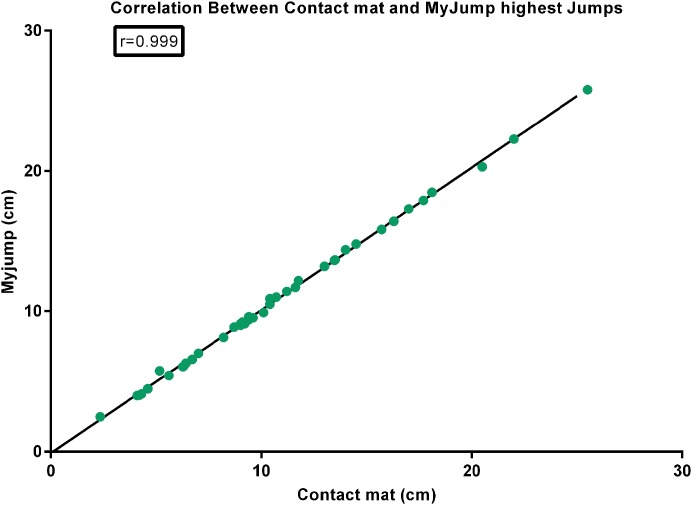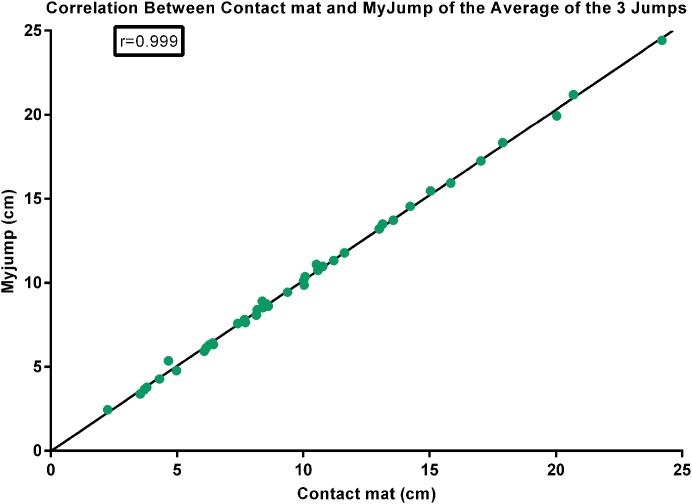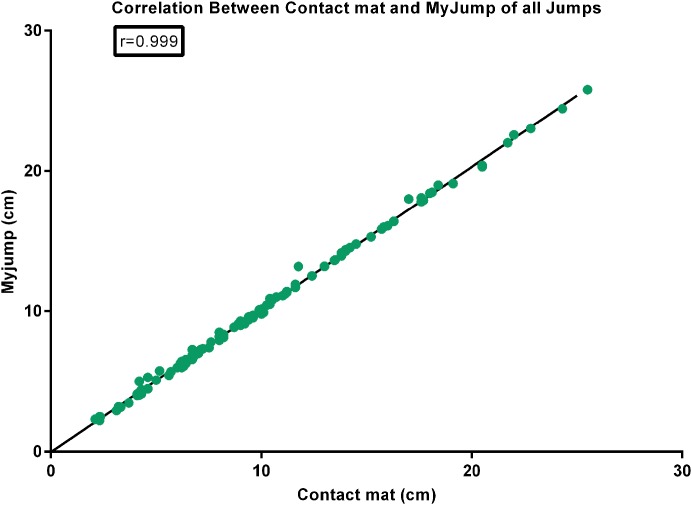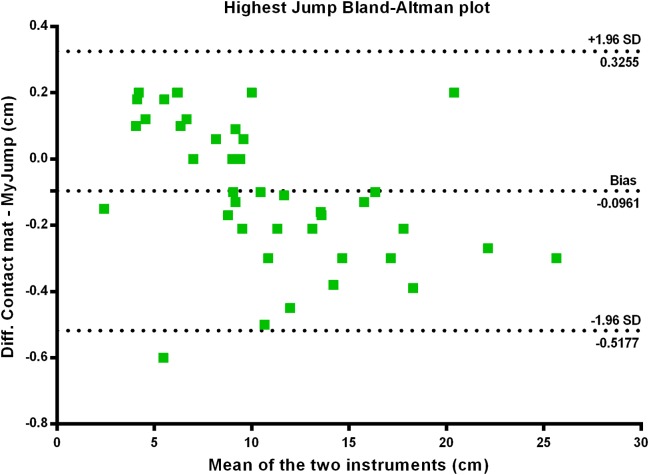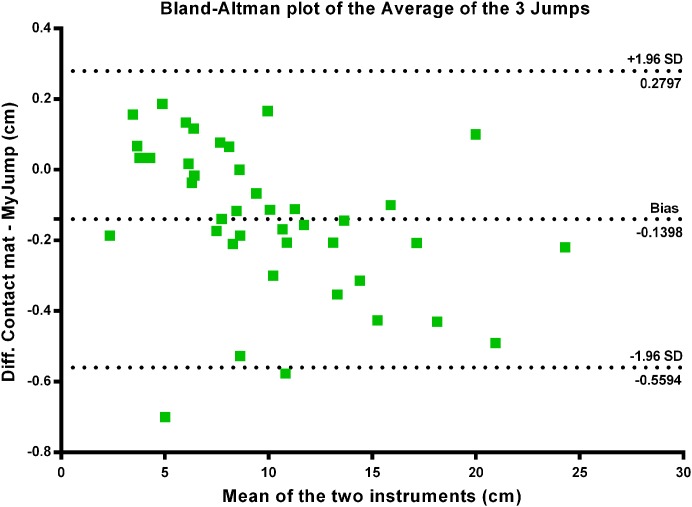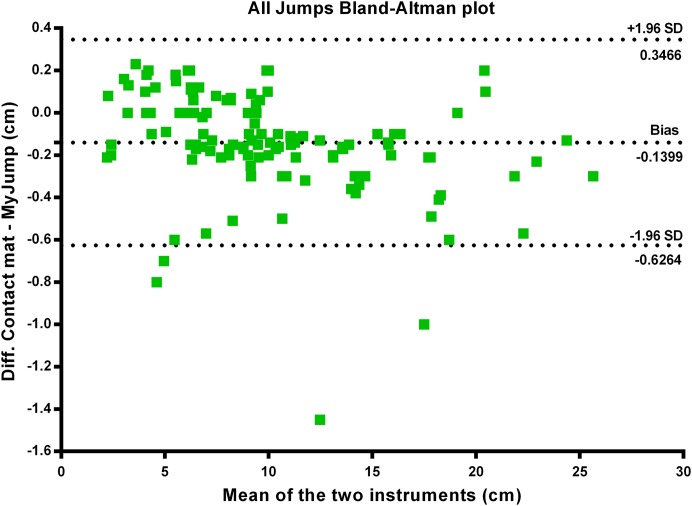Abstract
Background
The ability to jump has been related to muscle strength and power, speed and amplitude of the lower limbs movements, and specifically for the elderly, the vertical jump has been shown to be a good predictor of functional capacity and risk of falling. The use of a mobile application (App) which can measure the vertical jump (i.e., iPhone App My Jump) has recently emerged as a simple, cheap and very practical tool for evaluation of jump ability. However, the validity of this tool for the elderly population has not been tested yet. The elderly usually perform very low jumps and therefore the signal-to-noise ratio may compromise the validity and reliability of this method. Thus, the aim of the current study was to verify the validity and reliability of the iPhone App “My Jump” for the evaluation of countermovement jump (CMJ) height within an elderly population.
Methods
After familiarization, 41 participants performed three CMJs assessed via a contact mat and the My Jump App. The intraclass correlation coefficient (ICC) was used to verify the relative reliability, while the coefficient of variation (CV%) and the typical error of measurement (TEM) were used to verify the absolute reliability. Pearson’s correlation coefficient was used to verify the strength of the relationship between methods (i.e., concurrent validity), a Bland–Altman plot to show their agreement, and the Student’s t-test to identify systematic bias between them. For reliability analyses, all jumps were considered (i.e., 123). All jumps (i.e., 123), the average height of each attempt (i.e., 41), and the highest jump, were considered for validity analyses.
Results
The CMJ height of the highest jump was 10.78 ± 5.23 cm with contact mat, and 10.87 ± 5.32 with My Jump App, with an identified systematic bias of 0.096 cm (P = 0.007). There was a nearly perfect correlation between methods (r = 0.999; P = 0.000, in all cases) with a very good agreement observed (0.3255 to −0.5177 cm, 0.2797 to −0.5594 cm, and 0.3466 to −0.6264 cm, for highest jump height, average jump height, and all jump heights, respectively). The ICC of the My Jump App was 0.948, the TEM was 1.150 cm, and the CV was 10.10%.
Conclusion
Our results suggest that the My Jump App is a valid and reliable tool compared to the contact mat for evaluating vertical jump performance in the elderly. Therefore, it allows a simple and practical assessment of lower limbs’ power in this population. For the elderly, as well as for other populations with low jumping heights, the highest jump height and the average jump height could be used indistinctly.
Keywords: Explosiveness, Functional capacity, Physical capacity, Older, Seniors
Introduction
The vertical jump is a capacity of great interest and has been widely used as a measure of neuromuscular performance in professional (Klavora, 2000; Watkins et al., 2017) and recreational athletes (Driller et al., 2017; Boullosa et al., 2018), and in the elderly population among others (Petersen et al., 2007; Pijnappels et al., 2008). It is an indirect indicator of explosive muscular strength of the lower limbs (Balsalobre-Fernández, Glaister & Lockey, 2015; Markovic, 2007). The ability to jump has also been related to muscle strength and power, as well as speed and amplitude of lower limbs movements (Pijnappels et al., 2008).
Specifically, for the elderly, the vertical jump has been shown to be a good predictor of functional capacity (Pijnappels et al., 2008), and risk of falling (Lee, Biggan & Ray, 2016). It has been previously shown that loss of functional capacity interferes with the performance of activities of daily living (ADL) (Foldvari et al., 2000; Macaluso & De Vito, 2004; Farias et al., 2013), decreasing the independence in ADL, and also increasing the prevalence of falls (Lee, Biggan & Ray, 2016; Vieira et al., 2013). Therefore, it is reasonable to highlight that the vertical jump can be one of the most appropriate, useful, and suitable tests to evaluate the functional capacity of elderly people.
The instruments traditionally used for measuring the vertical jumps have been force platforms, infrared cells, video recording techniques, linear position transducers, and contact mats, which present good validity and accuracy/reliability in a variety of jumping techniques (Bosquet, Berryman & Dupuy, 2009; Carlos-Vivas et al., 2016; Pueo et al., 2017; Whitmer et al., 2015; Haynes et al., 2018). However, these instruments are relatively expensive and not easy to transport (Balsalobre-Fernández, Glaister & Lockey, 2015; Gallardo-Fuentes et al., 2016). This reality has recently changed with the use of a mobile application (App), which can measure the vertical jump height (i.e., iPhone App My Jump) (Balsalobre-Fernández, Glaister & Lockey, 2015; Carlos-Vivas et al., 2016; Driller et al., 2017). This App is very cheap and very practical to use in the most diverse situations (Driller et al., 2017; Haynes et al., 2018). The validity of this App has been tested for the young (Balsalobre-Fernández, Glaister & Lockey, 2015; Driller et al., 2017; Gallardo-Fuentes et al., 2016), presenting very good accuracy for jumping performance higher than ∼25 cm. However, the validity and reliability of this tool for the elderly population have not been tested yet. This is important since the elderly usually perform jumps lower than ∼20 cm (Farias et al., 2013) and therefore the signal-to-noise ratio may compromise the validity and reliability of this method in the elderly as well as other populations with low jumping values. Thus, the aim of this study was to verify the validity and reliability of the iPhone App My Jump for the evaluation of countermovement jump (CMJ) height of the elderly when compared to a contact mat, a previously validated method for other population (Balsalobre-Fernández, Glaister & Lockey, 2015; Yingling et al., 2018).
Materials and Methods
Study design
A sample of elderly people of both sexes was tested, after familiarization, with three maximal CMJs in the same day. All jumps (i.e., 123 jumps) measured with the App and the reference method (i.e., contact mat) as well as the highest jump and the average of the three attempts were used for concurrent validity analysis. The three jump heights measured with the App were used for intraday reliability analyses.
Participants
A total of 41 participants, 12 men (73.2 ± 6.4 years; 68.3 ± 12.7 kg) and 29 women (69.4 ± 8.9 years; 64.7 ± 12.6 kg), volunteered to participate in this study. A total of 13 were living in institutions while 28 were living with their families. Individuals who (a) were diagnosed with chronic obstructive pulmonary disease, (b) presented any form of intense pain, (c) or did not exhibit walking independence, were excluded from participation. After receiving information of the procedures, all of them signed an informed written consent. The study protocol adhered to the Code of Ethics of the World Medical Association (Declaration of Helsinki) and was approved by the Institutional Review Board (1.001.775).
Procedures
All participants were familiarized with CMJ technique before testing. The CMJ technique involved the participants standing in a fully extended position and feet approximately shoulder-width apart. Subsequently, they were instructed to jump as high as possible after performing a countermovement with the same take-off and landing positions. All participants performed four jumps in this familiarization session.
Jump testing was performed on a separate day between 8 and 10 a.m. after measurement of the volunteer body mass and warming up. Body mass was measured in a fasted state to the nearest 0.1 kg with a calibrated scale (PL 200; Filizola, São Paulo, Brazil). A standard 5 min warm-up composed of some calisthenics (sit-ups and sit-downs, ballistic movements in different positions) and three submaximal CMJs was subsequently performed. Then, each participant performed three maximal CMJs on a custom-made contact mat connected to a computer with specific software (Chronojump, version. 1.6.2; Boscosystem, Barcelona, Spain). This equipment has been previously demonstrated to be valid and reliable (Pagaduan & De Blas, 2004; De Blas et al., 2012). At the same time, the jump was recorded by the same researcher with a mobile (cell) phone (iPhone 7; Apple, Cupertino, CA, USA) at a sampling rate of 240 Hz, using the My Jump App.
Statistical analysis
Descriptive data are presented as mean ± SD. Normality was tested using the Shapiro–Wilk test. The homoscedasticity was verified with a scatter plot and with the Levene’s test when necessary. There is an inability to calculate reliability values when using the highest jump, due to the need for at least two measurements for the calculations. Therefore, the intraclass correlation coefficient (ICC; 2, 1) was applied to the three jumps to measure the relative reliability of the My Jump App. The absolute reliability of the App was calculated using the typical error of measurement (TEM) as the square root of the mean square error term from the ANOVA reported in absolute units, as well as coefficient of variation (CV%) (Weir, 2005). For concurrent validity, the analysis were performed using the highest jump (i.e., 41 jumps), the average of the three attempts (i.e., 41 jumps), and all jumps (i.e., 123) for a higher statistical power. For this purpose, Pearson’s correlation coefficient was used to verify the strength of the relationship between methods. Subsequently, a Bland–Altman plot was used to show their agreement (Bland & Altman, 1986), and a student’s t-test was performed to verify if there was a significant bias between methods. The statistical significance level was set at P < 0.05. Statistical analyses were performed with a statistical package (IBM SPSS version 22.0; SPSS, Chicago, IL, USA).
Results
The vertical jump heights in all attempts, the highest jump height, and the average of the three attempts measured with the two methods are presented in Table 1.
Table 1. Mean ± SD for jump heights recorded with the two methods.
| Contact mat | My Jump App | Student’s P | Pearson’s r (P) | |
|---|---|---|---|---|
| All jumps height (cm) | 10.01 ± 5.08 | 10.15 ± 5.16 | 0.000 | 0.999 (0.000) |
| Average jump height (cm) | 10.01 ± 5.03 | 10.15 ± 5.11 | 0.000 | 0.999 (0.000) |
| Highest jump height (cm) | 10.78 ± 5.23 | 10.87 ± 5.32 | 0.007 | 0.999 (0.000) |
| First jump height (cm) | 9.78 ± 4.78 | 9.90 ± 4.86 | 0.001 | 0.999 (0.000) |
| Second jump height (cm) | 9.88 ± 5.28 | 9.99 ± 5.33 | 0.001 | 0.999 (0.000) |
| Third jump height (cm) | 10.36 ± 5.27 | 10.55 ± 5.39 | 0.000 | 0.999 (0.000) |
There were nearly perfect correlations between the My Jump App and the contact mat heights using the highest jump (r = 0.999; P = 0.000) (see Fig. 1), the average of the three jumps (r = 0.999; P = 0.000) (see Fig. 2), as using all jumps (r = 0.999; P = 0.000) (see Fig. 3). The difference between the two methods using the highest jump was 0.096 cm with limits of agreement from 0.3255 cm to −0.5177 cm (see Fig. 4), while the difference between methods and limits of agreement of the methods using the average of the three jumps or all 123 jumps were higher (see Figs. 5 and 6, respectively). Good agreement was observed in all cases. However, the t-test showed significant differences between methods (see Table 1).
Figure 1. Correlation between contact mat and My Jump highest jumps.
Figure 2. Correlation between contact mat and My Jump of the average of the three jumps.
Figure 3. Correlation between contact mat and My Jump of all jumps.
Figure 4. Highest jump Bland–Altman plot.
Figure 5. Bland–Altman plot of the average of three jumps.
Figure 6. All jumps Bland–Altman plot.
The My Jump App also showed excellent reliability levels (ICC = 0.948, TEM = 1.15, CV% = 10.096). The reliability results of both methods are presented in Table 2. Although the method presented high reliability, the analysis of variance employed for the calculation of the ICC showed a significant (P = 0.000) difference between the means, with higher mean height values for the third jump.
Table 2. Relative (ICC) and absolute (TEM and CV%) reliability of the two methods.
| ICC (95%CI) | TEM (cm) | CV% | |
|---|---|---|---|
| Contact mat | 0.949 (0.916–0.971) | 1.128 | 10.111 |
| My Jump App | 0.948 (0.913–0.970) | 1.150 | 10.096 |
Note:
ICC, intraclass correlation coefficient; TEM, typical error of measurement; CV%, TEM as a coefficient of variation.
Discussion
The present investigation aimed to analyze the validity and reliability of the My Jump App for measuring jump height in the elderly. Our main findings showed a very good agreement of jump height recorded with the My Jump App with the reference method, as well as an almost perfect correlation. Further, intraday reliability levels were also very good.
To our knowledge, the My Jump App has never been used before for evaluating the vertical jump height in the elderly. Studies with other populations have demonstrated its validity and applicability (Balsalobre-Fernández, Glaister & Lockey, 2015; Carlos-Vivas et al., 2016; Driller et al., 2017). Previously, Balsalobre-Fernández, Glaister & Lockey (2015) validated this App for other populations and higher jumping values with a 120 Hz high-speed camera. The results of the current study extend its use to populations with lower values for jumping, which highlights the suitability of My Jump App for an elderly population. It is important to consider that in our study we used an iPhone model with a 240 Hz high-speed camera. The relatively higher video frequency (for a mobile/cell phone) could have contributed to the reduction in the measurement error of the My Jump App, especially for this population with such low jump height levels. Thus, practitioners in training and clinical settings may benefit from this easy-to-use, portable and affordable tool for this special population. Further studies should verify the minimum sampling rate of the mobile camera needed to maintain the results obtained in the current study, as well as the concurrent validity when considering other methods as force plates.
Our data presented in Bland–Altman plots (see Figs. 4–6) showed that the majority of the CMJ values are close to the mean of the differences between the two devices, thereby representing a high level of agreement (Bland & Altman, 1986). However, the slightly better agreement between methods for the highest jump (0.3255 to −0.5177 cm, 0.2797 to −0.5594 cm, and 0.3466 to −0.6264 cm, for highest jump height, average jump height, and all jumps height, respectively) would suggest that the highest jump height may be the best measure to identify performance changes in this population, adding further evidence to the previous suggestions by Claudino et al. (2017). However, there is an inability to calculate reliability values when using the highest jump. In addition, the almost near perfect correlation between methods confirms its concurrent validity (see Figs. 1–3). Meanwhile, the significant differences between methods indicates a systematic error with higher jumping heights with the My Jump App when compared to the contact mat (see Table 1). Therefore, comparisons between values from different studies obtained with different methods should consider this small bias. In addition, the My Jump App also showed excellent intraday absolute and relative reliability levels (ICC = 0.948, TEM = 1.15, CV% = 10.096) (see Table 2). However, the analysis of variance of the ICC revealed a significant difference for the last jump, with systematically higher jumping heights. From our observations, it could be speculated that the participants experienced greater confidence during the last attempts, therefore performing higher jumps. Another possibility is that an extensive dynamic warm-up was not provided prior to the jumps and thus the initial CMJ acted as a warm-up to potentiate the final CMJ. Further studies should elaborate on this issue, which could be also suggesting a possible learning or warm-up effect despite a previous familiarization session.
The vertical jump has been successfully used to evaluate individuals from a wide range of ages, showing lower values as age increases (Izquierdo et al., 1999; Runge et al., 2004). Our results are in agreement with the literature, showing lower mean values of the elderly in CMJ height when compared to younger populations (Izquierdo et al., 1999), and very similar to those obtained by others (Ditroilo et al., 2010; Farias et al., 2013) with a similar age group. An explanation for lower jump heights may be due to the decrease of muscle power during the ageing process as a consequence of the combination of a number of factors (e.g., neuromuscular, hormonal, genetic), which has been demonstrated to be more accentuated than the decrease in muscle mass (Alcazar et al., 2017) and maximal strength (Runge et al., 2004). CMJ height (cm) is a very simple measure directly linked to muscle power (Boullosa et al., 2018), which is one of the most important physical capacities related to the functional capacity (Pijnappels et al., 2008), risk of falls (Lord, Menz & Tiedemann, 2003), and independence of the elderly (Alcazar et al., 2017).
The main limitation of the methodology used by the My Jump App to measure jump height is the fact that the user has to manually select the frames in which the individual exactly performs the take-off and landing moments, thus making the measurement process subjective and time demanding in some cases. Moreover, another limitation could be the jumping technique of some participants who may be afraid of falling, therefore possibly compromising maximal performances in some cases. We could suggest that these issues could be easily overcome after familiarization of both practitioners and elderly. It is therefore unknown if more jump attempts would result in higher best jumps. On the other hand, there is an inability to calculate reliability values when using the highest jump, due to the need for at least two measurements for the calculations. Therefore, it was not possible to compare the TEM between the highest jump and the others used in the present study. Further studies should elaborate on this issue with more familiarization sessions to avoid a learning effect, which could not be excluded in the present investigation despite a previous familiarization session before evaluations.
The results of this study suggest that My Jump is a valid and reliable tool for measuring jump height in elderly people. Given its simplicity and practicality, it could be used by practitioners at different times and conditions for a rapid evaluation of the vertical jump capacity in the elderly. This would allow the evaluation of changes in functional capacity with a robust and simple test as CMJ. Furthermore, absolute and relative reliability measures demonstrated excellent results. Therefore, in addition to its low-cost compared with several reference methods available, the My Jump App can be considered a valid and reliable tool for calculating jump height in elderly people.
Conclusion
The present study shows that the My Jump App presents a very high agreement with contact mat as reference method, demonstrating an excellent reliability. Therefore, in addition to its low-cost and simplicity, this method could be considered valid and reliable to calculate jump height in elderly people as in other populations. The highest jump and the average of jumps could be indistinctly used for identification of acute and chronic adaptations in vertical jumping capacity of the elderly.
Supplemental Information
Acknowledgments
We would like to thank Dr. David Behm for his advice and the English revision of the manuscript.
Funding Statement
André Ricarte Medeiros (UC17351170) received a PROSUP scholarship grant from CAPES. Daniel A. Boullosa received a productivity grant from CNPq (305131/2015-0). The funders had no role in study design, data collection and analysis, decision to publish, or preparation of the manuscript.
Additional Information and Declarations
Competing Interests
The authors declare that they have no competing interests.
Author Contributions
Rejane Maria Cruvinel-Cabral conceived and designed the experiments, performed the experiments, analyzed the data, contributed reagents/materials/analysis tools, authored or reviewed drafts of the paper, approved the final draft.
Iransé Oliveira-Silva conceived and designed the experiments, performed the experiments, analyzed the data, contributed reagents/materials/analysis tools, prepared figures and/or tables, authored or reviewed drafts of the paper, approved the final draft.
André Ricarte Medeiros conceived and designed the experiments, performed the experiments, analyzed the data, contributed reagents/materials/analysis tools, prepared figures and/or tables, authored or reviewed drafts of the paper, approved the final draft.
João Gustavo Claudino conceived and designed the experiments, analyzed the data, contributed reagents/materials/analysis tools, authored or reviewed drafts of the paper, approved the final draft.
Pedro Jiménez-Reyes analyzed the data, authored or reviewed drafts of the paper, approved the final draft.
Daniel A. Boullosa conceived and designed the experiments, contributed reagents/materials/analysis tools, authored or reviewed drafts of the paper, approved the final draft.
Human Ethics
The following information was supplied relating to ethical approvals (i.e., approving body and any reference numbers):
The study protocol adhered to the Code of Ethics of the World Medical Association (Declaration of Helsinki) and was approved by the Institutional Review Board (1.001.775).
Data Availability
The following information was supplied regarding data availability:
The raw data are provided in a Supplemental File.
References
- Alcazar et al. (2017).Alcazar J, Guadalupe-Grau A, García-García FJ, Ara I, Alegre LM. Skeletal muscle power measurement in older people: a systematic review of testing protocols and adverse events. Journals of Gerontology: Series A. 2017;73(7):914–924. doi: 10.1093/gerona/glx216. [DOI] [PubMed] [Google Scholar]
- Balsalobre-Fernández, Glaister & Lockey (2015).Balsalobre-Fernández C, Glaister M, Lockey RA. The validity and reliability of an iPhone App for measuring vertical jump performance. Journal of Sports Sciences. 2015;33(15):1574–1579. doi: 10.1080/02640414.2014.996184. [DOI] [PubMed] [Google Scholar]
- Bland & Altman (1986).Bland JM, Altman D. Statistical methods for assessing agreement between two methods of clinical measurement. Lancet. 1986;327(8476):307–310. doi: 10.1016/s0140-6736(86)90837-8. [DOI] [PubMed] [Google Scholar]
- Bosquet, Berryman & Dupuy (2009).Bosquet L, Berryman N, Dupuy O. A comparison of 2 optical timing systems designed to measure flight time and contact time during jumping and hopping. Journal of Strength and Conditioning Research. 2009;23(9):2660–2665. doi: 10.1519/JSC.0b013e3181b1f4ff. [DOI] [PubMed] [Google Scholar]
- Boullosa et al. (2018).Boullosa D, Abreu L, Conceição F, Cordero Y, Jimenez-Reyes P. The influence of training background on different rate of force development calculations during countermovement jump. Kinesiology. 2018;50(1):90–95. [Google Scholar]
- Carlos-Vivas et al. (2016).Carlos-Vivas J, Martin-Martinez JP, Hernandez-Mocholi MA, Perez-Gomez J. Validation of the iPhone App using the force platform to estimate vertical jump height. Journal of Sports Medicine and Physical Fitness. 2016;58(3):227–232. doi: 10.23736/S0022-4707.16.06664-0. [DOI] [PubMed] [Google Scholar]
- Claudino et al. (2017).Claudino JG, Cronin J, Mezêncio B, McMaster DT, McGuigan M, Tricoli V, Amadio AC, Serrão JC. The counter movement jump to monitor neuromuscular status: A meta-analysis. Journal of Science and Medicine in Sport. 2017;20(4):397–402. doi: 10.1016/j.jsams.2016.08.011. [DOI] [PubMed] [Google Scholar]
- De Blas et al. (2012).De Blas X, Padullés JM, López Del Amo JL, Guerra-Balic M. Creation and validation of chronojump-boscosystem: a free tool to measure vertical jumps. Revista Internacional De Ciencias Del Deporte. 2012;8(30):334–356. [Google Scholar]
- Ditroilo et al. (2010).Ditroilo M, Forte R, Benelli P, Gambarara D, De Vito G. Effects of age and limb dominance on upper and lower limb muscle function in healthy males and females aged 40–80 years. Journal of Sports Science. 2010;28(6):667–677. doi: 10.1080/02640411003642098. [DOI] [PubMed] [Google Scholar]
- Driller et al. (2017).Driller M, Tavares F, McMaster D, O’Donnell S. Assessing a smartphone application to measure counter-movement jumps in recreational athletes. International Journal of Sports Science & Coaching. 2017;12(5):661–664. doi: 10.1177/1747954117727846. [DOI] [Google Scholar]
- Farias et al. (2013).Farias DL, Teixeira TG, Madrid B, Pinho D, Boullosa DA, Prestes J. Reliability of vertical jump performance evaluated with contact mat in elderly women. Clinical Physiology and Functional Imaging. 2013;33(4):288–292. doi: 10.1111/cpf.12026. [DOI] [PubMed] [Google Scholar]
- Foldvari et al. (2000).Foldvari M, Clark M, Laviolette LC, Bernstein MA, Kaliton D, Castaneda C, Pu CT, Hausdorff JM, Fielding RA, Singh MA. Association of muscle power with functional status in community-dwelling elderly women. Journals of Gerontology Series A: Biological Sciences and Medical Sciences. 2000;55(4):M192–M199. doi: 10.1093/gerona/55.4.m192. [DOI] [PubMed] [Google Scholar]
- Gallardo-Fuentes et al. (2016).Gallardo-Fuentes F, Gallardo-Fuentes J, Ramírez-Campillo R, Balsalobre-Fernández C, Martínez C, Caniuqueo A, Cañas R, Banzer W, Loturco I, Nakamura FY, Izquierdo M. Intersession and intrasession reliability and validity of the My Jump App for measuring different jump actions in trained male and female athletes. Journal of Strength and Conditioning Research. 2016;30(7):2049–2056. doi: 10.1519/JSC.0000000000001304. [DOI] [PubMed] [Google Scholar]
- Haynes et al. (2018).Haynes T, Bishop C, Antrobus M, Brazier J. The validity and reliability of the My Jump 2 App for measuring the reactive strength index and drop jump performance. Journal of Sports Medicine and Physical Fitness. 2018 doi: 10.23736/S0022-4707.18.08195-1. Epub ahead of print. [DOI] [PubMed] [Google Scholar]
- Izquierdo et al. (1999).Izquierdo M, Aguado X, Gonzalez R, Lopez J, Häkkinen K. Maximal and explosive force production capacity and balance performance in men of different ages. European Journal of Applied Physiology and Occupational Physiology. 1999;79(3):260–267. doi: 10.1007/s004210050504. [DOI] [PubMed] [Google Scholar]
- Klavora (2000).Klavora P. Vertical-jump tests: a critical review. Strength and Conditioning Journal. 2000;22(5):70–75. doi: 10.1519/1533-4295(2000)022<0070:vjtacr>2.0.co;2. [DOI] [Google Scholar]
- Lee, Biggan & Ray (2016).Lee A, Biggan JR, Ray C. Fitness, balance efficacy, and postural control in community-dwelling older adults. Sage Open. 2016;6(1):1–7. doi: 10.1177/2158244016631798. [DOI] [Google Scholar]
- Lord, Menz & Tiedemann (2003).Lord SR, Menz HB, Tiedemann A. A physiological profile approach to falls risk assessment and prevention. Physical Therapy. 2003;83(3):237–252. doi: 10.1093/ptj/83.3.237. [DOI] [PubMed] [Google Scholar]
- Macaluso & De Vito (2004).Macaluso A, De Vito G. Muscle strength, power and adaptations to resistance training in older people. European Journal of Applied Physiology. 2004;91(4):450–472. doi: 10.1007/s00421-003-0991-3. [DOI] [PubMed] [Google Scholar]
- Markovic (2007).Markovic G. Does plyometric training improve vertical jump height? A meta-analytical review. British Journal of Sports Medicine. 2007;41(6):349–355. doi: 10.1136/bjsm.2007.035113. [DOI] [PMC free article] [PubMed] [Google Scholar]
- Pagaduan & De Blas (2004).Pagaduan JC, De Blas X. Reliability of countermovement jump performance on chronojump-boscosystem in male and female athletes. Sport Scientific and Pratical Aspects. 2004;10(2):5–8. [Google Scholar]
- Petersen et al. (2007).Petersen K, Hansen CB, Aagaard P, Madsen K. Muscle mechanical characteristics in fatigue and recovery from a marathon race in highly trained runners. European Journal of Applied Physiology. 2007;101(3):385–396. doi: 10.1007/s00421-007-0504-x. [DOI] [PubMed] [Google Scholar]
- Pijnappels et al. (2008).Pijnappels M, Van Der Burg JCE, Reeves ND, Van Dieën JH. Identification of elderly fallers by muscle strength measures. European Journal of Applied Physiology. 2008;102(5):585–592. doi: 10.1007/s00421-007-0613-6. [DOI] [PMC free article] [PubMed] [Google Scholar]
- Pueo et al. (2017).Pueo B, Lipinska P, Jiménez-Olmedo JM, Zmijewski P, Hopkins WG. Accuracy of jump-mat systems for measuring jump height. International Journal of Sports Physiology and Performance. 2017;12(7):959–963. doi: 10.1123/ijspp.2016-0511. [DOI] [PubMed] [Google Scholar]
- Runge et al. (2004).Runge M, Rittweger J, Russo CR, Schiessl H, Felsenberg D. Is muscle power output a key factor in the age-related decline in physical performance? A comparison of muscle cross section, chair-rising test and jumping power. Clinical Physiology and Functional Imaging. 2004;24(6):335–340. doi: 10.1111/j.1475-097X.2004.00567.x. [DOI] [PubMed] [Google Scholar]
- Vieira et al. (2013).Vieira DCL, Tibana RA, Tajra V, Da Cunha Nascimento D, De Farias DL, De Oliveira Silva A, Teixeira TG, Fonseca RMC, De Oliveira RJ, Dos Santos Mendes FA, Martins WR, Funghetto SS, Karnikowski MG, Navalta JW, Prestes J. Decreased functional capacity and muscle strength in elderly women with metabolic syndrome. Clinical Interventions in Aging. 2013;8:1377–1386. doi: 10.2147/CIA.S50333. [DOI] [PMC free article] [PubMed] [Google Scholar]
- Watkins et al. (2017).Watkins CM, Barillas SR, Wong MA, Archer DC, Dobbs IJ, Lockie RG, Coburn JW, Tran TT, Brown LE. Determination of vertical jump as a measure of neuromuscular readiness and fatigue. Journal of Strength and Conditioning Research. 2017;31(12):3305–3310. doi: 10.1519/JSC.0000000000002231. [DOI] [PubMed] [Google Scholar]
- Whitmer et al. (2015).Whitmer TD, Fry AC, Forsythe CM, Andre MJ, Lane MT, Hudy A, Honnold DE. Accuracy of a vertical jump contact mat for determining jump height and flight time. Journal of Strength and Conditioning Research. 2015;29(4):877–881. doi: 10.1519/JSC.0000000000000542. [DOI] [PubMed] [Google Scholar]
- Weir (2005).Weir JP. Quantifying test-retest reliability using the intraclass correlation coefficient and the SEM. Journal of Strength and Conditioning Research. 2005;19(1):231–240. doi: 10.1519/15184.1. [DOI] [PubMed] [Google Scholar]
- Yingling et al. (2018).Yingling VR, Castro DA, Duong JT, Malpartida FJ, Usher JR, O J. The reliability of vertical jump tests between the Vertec and My Jump phone application. PeerJ. 2018;6:e4669. doi: 10.7717/peerj.4669. [DOI] [PMC free article] [PubMed] [Google Scholar]
Associated Data
This section collects any data citations, data availability statements, or supplementary materials included in this article.
Supplementary Materials
Data Availability Statement
The following information was supplied regarding data availability:
The raw data are provided in a Supplemental File.



